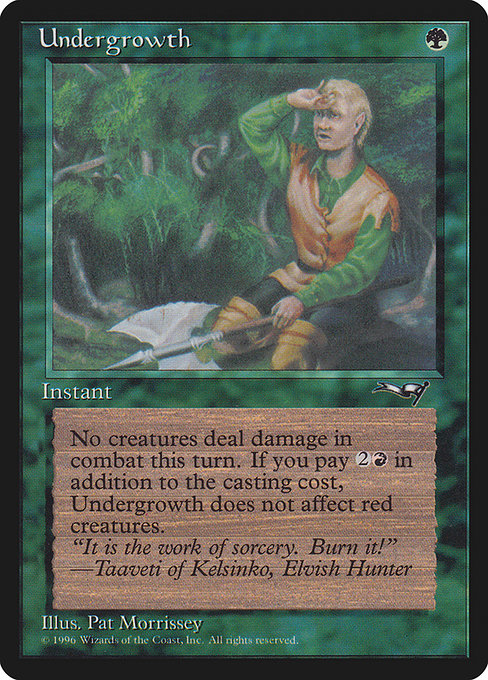
Image courtesy of Scryfall.com
When Nostalgia Becomes Value: Undergrowth in the Collector's Market
There’s something quietly magical about the Alliances era—a window into a time when Magic’s design team experimented with new ideas at a breakneck pace and printers chased the thrill of novelty. Undergrowth captures that spirit in a single, almost deceptively simple instant. For green lovers, it offers a straightforward, mana-efficient spell; for players who adore a dash of red-fire in their green decks, it teases with an optional cost that changes the math of an entire combat turn. And for collectors, the card’s lineage—a 1996 print from the Alliances set, illustrated by Pat Lewis—becomes a touchstone of nostalgia that can translate into long-term value, even if the card remains common and nonfoil. 🧙♂️💎
Undergrowth is a compact statement of design: one green mana, instant speed, and a two-part decision that folds two colors into a single effect. Its oracle text reads as a practical protective measure: “As an additional cost to cast this spell, you may pay {2}{R}. Prevent all combat damage that would be dealt this turn. If this spell's additional cost was paid, this effect doesn't affect combat damage that would be dealt by red creatures.” In other words, you can salt the earth with a high-velocity financial-cost-of-access to immunity for the turn, while acknowledging that red’s blitz can still slay with gusto. It’s a tiny cognitive puzzle that rewards careful timing—a hallmark of MTG set design in its golden era. ⚔️
- Mana cost and color identity: {G} is clean and economical, but the card’s color-identity span of G and R hints at the era’s experimental spirit with cross-color interactions. In a world where color identity was already shaping deckbuilding corners, Undergrowth invites green players to consider red as a partner rather than an adversary.
- Extra-cost twist: The option to pay {2}{R} adds a tactical dimension. If you choose to pay, you gain protection from combat damage for the turn—but you also narrow the effect’s reach by excluding red creatures. That’s a deliberately playful constraint, one that rewards planning and sequencing in response to what the battlefield looks like at the moment you cast it.
- Flavor and lore: The flavor text—“It is the work of sorcery. Burn it!”—speaks to the Elvish hunter Taaveti of Kelsinko and the era’s penchant for bold, character-driven lines that feel both ethnically grounded and mythic. The flavor invites players to imagine a forest alight with elven cunning, even as you hold back a forest’s wrath for just one turn. 🔥🎨
- Art and printing history: Pat Lewis’s illustration has that late-90s polish—clean lines, crisp colors, a sense of motion that makes the spell feel alive on the page. In collector circles, the Allis era is prized for its distinctive borders and early-photography-like print quality, a visual fingerprint that many players associate with a more tactile era of the game.
- Rarity and market reality: As a common from Alliances, Undergrowth exists in abundance relative to rares and mythics, but nostalgia often confers outsized sentiment value. The card’s nonfoil status and its 1996 printing contribute to a familiar story: accessible entries for new players, yet cherished by longtime fans who recall a different era of play—where creatures clashed with the primal forest in a more personal, less digital way. 💎
For collectors, nostalgia is more than sentiment—it’s a lens through which the past feels tangible in the present. The allure of Undergrowth rests not only in its mechanical niche but in the story it tells about MTG’s early days: a game that could hinge on a single instant, a clever cost, and a moment where green’s protective instinct meets red’s risk-taking bravado. In an age of reprints and chase headlines, this card offers a quiet, durable appeal for players who adore the lineage of the game as much as the outcomes of their matches. 🧙♂️⚔️
Cross-promotions can feel a little serendipitous, but the synergy is real when you’re building a culture around MTG’s past and present. Imagine a modern, on-the-go collecting experience—like pairing a retro-styled sleeve with a sleek, MagSafe-ready card holder. Our featured product, Neon Card Holder MagSafe Phone Case for iPhone 13 Galaxy S21 S22, brings a contemporary twist to a hobby rooted in a very tactile, very nostalgic era. It’s a small way to celebrate that love for the cards, the artwork, and the stories that those old spells inspired in the days of paper-only battles. If you’re chasing that “feel” on a daily basis, the product link below makes it easy to blend MTG fandom with modern gear. 🔗🧭
Undergrowth’s enduring appeal isn’t about raw power on the battlefield; it’s about the memory landscape that surrounds a simple green instant, and how nostalgia can ripple into collector value when you connect the past with today’s hobbies. The card’s price point, historically modest in USD and EUR, becomes a narrative device—one that invites players to reflect on their own connection to MTG’s golden age, and to consider how that connection informs their collecting journey. In the end, nostalgia isn’t just a mood; it’s a durable driver of meaning and value for a card that offered a clever, dual-color experience in a single act of magic. 🧩
Product note: Keep an eye on the broader ecosystem—older prints sometimes gain incremental interest as new generations discover the game’s roots, and as condition-sensitive cards become stepping stones to deeper collections. For those who savor the tactile joy of old-school MTG, Undergrowth stands as a neat bridge between past and present—an evergreen reminder that strategy, lore, and art can coexist in a single, small spell.
Neon Card Holder MagSafe Phone Case for iPhone 13 Galaxy S21 S22More from our network
- https://blog.digital-vault.xyz/blog/post/design-empathy-for-highland-lake-embracing-diverse-mtg-playstyles/
- https://blog.rusty-articles.xyz/blog/post/photometric-window-into-a-hot-early-type-stellar-atmosphere/
- https://blog.digital-vault.xyz/blog/post/tracking-fast-stars-with-dr3-clues-and-a-hot-32k-k-star/
- https://blog.digital-vault.xyz/blog/post/the-science-of-texture-perception-in-modern-design/
- https://transparent-paper.shop/blog/post/mastering-workflow-automation-for-solo-creators/